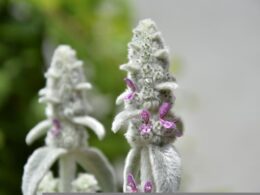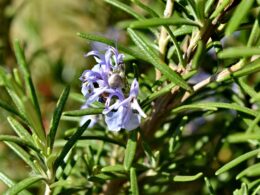Blue Daisy Flower Appearance
The blue daisy flower produces numerous extremely regular branches while developing as ground cover. It generally grows to a height of around 50 cm (1.6 ft) tall, but it can reach up to 1 m in rare cases. The leaves are dark green and elliptical, and are oppositely arranged along the stems.
The flower heads are set on stems that may reach up to 18 centimeters (7 inches) long, green to dark reddish in color. They include about twelve brilliant blue ray florets surrounding many yellow disc florets, which measure roughly 3 centimeters (1 inch).
Felicia Amelloides Distribution and Habitat
The blue daisy flower is found in a strip along the south coast of the Western Cape and Eastern Cape provinces of South Africa, from De Hoop Nature Reserve to Kei River in the east. It extends near Port Elizabeth, Groot Winterhoek Mountains near Uitenhage, and Ecca Pass, on the road between Grahamstown and Fort Beaufort. They grow on old sand dunes, stony hillsides, and where the shelter is provided.
Blue Felicia Daisy Growing Conditions
The blue daisy flower is a beautiful and popular choice for many gardens. They are easy to care for and make an excellent addition to any garden. Here are a few tips on how to care for your blue daisy.
Light Requirements for Blue Daisy Flowers
The blue daisy flower does best in full sun but can also tolerate partial shade. If you live in an area with hot summers, it is best to plant blue daisy in a location that gets some afternoon shade.
Water Requirements for Blue Daisy Flowers
The blue daisy flower is relatively drought tolerant once established, however, it will need regular watering during the first growing season. Once established, water the blue daisy flower once a week during periods of prolonged drought. 1 to 2 inches of water per week is sufficient.
Fertilizer Requirements for Blue Daisy Flowers
The blue daisy flower does not require a lot of fertilizer, however, they will benefit from a light application of fertilizer in the spring. Use a general purpose fertilizer and apply according to the manufacturer’s directions.
Pruning Requirements for Blue Daisy Flowers
The blue daisy flower does not require a lot of pruning, however, they can be cut back after blooming to encourage re-blooming in midsummer. In late summer or early fall, you can cut the plants and encourage new growth.
Pests and Diseases of Blue Daisy Flowers
Blue daisy flowers are generally pest- and disease- free. However, there are a few common problems that can arise. These include aphids and whiteflies. Aphids are small, winged insects that feed on plant sap. They can cause stunted growth and distorted leaves.
Whiteflies are tiny white bugs that also suck plant sap. They can cause wilting, yellowing, and stunted growth. If you see either of these pests on your Blue Daisy flowers, you can remove them by spraying the plants with water from a hose. You can also use an insecticidal soap or neem oil to control these pests.
Soil Requirements for Blue Daisy Flower
The blue daisy flower prefers well-drained soils but can tolerate most soil types as long as it is not waterlogged. The best soil is chalk, loam or sand and the zone in which they grow best is 8-11.
When to Plant Blue Daisy Flower
The best time to plant blue daisy flower is in the early spring, several weeks before the last expected frost date. You can also plant them in the fall, however, they may not bloom as profusely.
How to Grow Blue Daisy Flower?
The seeds should be sowed evenly about 12 inches apart and covered with 1/4 inch of soil. The soil should be firmed lightly with a hand and kept evenly moist. The seedlings should emerge in 7 to 10 days. They should stand 12 to 18 inches apart, when they’re about 1-2 inches tall, but it depends on the variety.



















